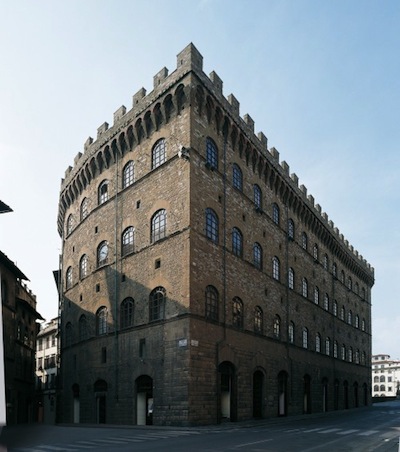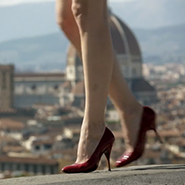Italian fashion label Salvatore Ferragamo is honoring its Florentine roots as the city celebrates 150-years as the figurative “capital” of Italy.
When the Italian city-states were unified in 1865, Florence was selected as the capital of the Kingdom of Italy and Palazzo Spini Feroni was named city hall. From May 8 until April 3, 2016, Ferragamo’s in-house museum, Museo Ferragamo, will honor the Palazzo Spini Feroni, the home of its headquarters and flagship boutique.
Celebrate your roots
Ferragamo’s “A Palace and the City” celebrates both Florence and Palazzo Spini Feroni on via Tornabuoni through works of art and documents from museums and private collections around the world. These exhibit items tell the story behind the palace and its residences since it was built in 1289 for the cloth merchant and banker Geri Spini.
Curated by Stefania Ricci and Riccardo Spinelli, the exhibition’s displays, envisioned by set designer Maurizio Balo, examine the Palazzo Spini Feroni’s historical and architectural value and its importance for the city of Florence. Also, museum-goers will learn about the Ferragamo family’s role in restoring the building to its original splendor.
In his autobiography, namesake brand founder Salvatore Ferragamo said, “Long before I ever moved into the Palazzo Spini Feroni it was one of the buildings of Florence that I most admired and loved.”

Palazzo Spini Feroni in Florence, Italy
Mr. Ferragamo purchased the building in 1938 and made Palazzo Spini Feroni his brand’s headquarters with the museum opening in 1995. Although not originally from Florence, Mr. Ferragamo selected the city as the home of his brand due to its connection to art, culture, tradition, creativity, elegance and the quintessence of Italian lifestyle.
Not only does the Museo Ferragamo inspire consumer aspiration, it also establishes continuity of tradition among employees. Mr. Ferragamo was a prolific creative mind, leaving behind thousands of archived items that compose the bulk of his eponymous museum.
When training new employees, visiting the museum is oftentimes the best way to impart the spirit of the brand (see story).
{"ct":"BDMH5KCQSBDo20RiTaXWLkTaS7Zh1rSO84\/JBYA9bvdGrZl2B7zSOJ8z8LfSarY\/Z6ajnQ5ykf+y2T9n6ng2p3s+aWB10Ygf1nriapS6kdwFJpeGXxHFwNgqSXOwoymbBENHIgzj4MBgCejDgkLwy4pBmfwF7E8vOfxjd29a1VSeYlq6e5kky+uXEQ8rvWRE3SfzBR5uGn75CtNx6Go\/5TWyzYmuwCebj2lluC\/JAmeQKj2ugWDG6KZI8yD0\/+xNQO5WLb4tjaV30614kyfB0Fn6yvE5GdOzKF1u+onYKz2VF1Wym0L+qST+fADwybjtFGXyu9n2x0i8qqFXiZayFN7bBZPq9YB0UMtrVSCd3e+AFyVWEXBW\/mV6Mk0s7AxqviuWiZgSYECg3KsjaV5bwJjkc0PV020Lbqup7UgrozizMa1LLSR8VjZH7IrQizwPnJN+s+d8QB5Dx0hZMngeT\/huhMuj2C4iEk5UyUh49CcoboTdpUJbQk0dwjtPHMvHuRUf3Q\/wvitabScOCO9Ype8m5L\/3k2vhzWgVWQqpwszbn47bUQuRJgwo4Xjx0OoDJq1nvGLmBOOwVSRoeEwcERF6TeuNCIN4DiKg9D3nnixqAXeOQQiVZ+0jr+hL9LF2XUfkK6iVCSxTldwCPjyPPJMdqrG8Sn9Pjf6S\/ZnfV6N6dOLv6VE4dhZLwOdJIGQEXH7i\/WROQgYZl+4mTAgCXHpv9iUcFEv3NVeT0mlIILCN7d+ONP41t\/zwJxtSWj\/5733RADRpFQei5+n4dajFkpgH8ip2Qo57GYM+yL8ZB5DwcEiMxHv+Tz78Duvpca18rb8hgc1uyg97z1Qdzaeix+COQj5zw8IBh+Y\/KvtaQhWMsuc5Y6LreSETcykOlOiDht9I7E2K1i1I0bzsAvKKPHByo5yWz6WI+7w8TgRy8tP3FwLjoFgQfrrByrWzCHHfmCHeJSbNEUawjxD4P7rzWkfTLZ4QHB+PF02opG253UQk5cC8wtrduLeX3fMit476yrmYT8RqR\/3hVFXoaYvONjLEcgThR1C9UCxql9Ac7n\/\/c7COKme2P3cgeEjedokEwlefze8K6a3fuiGp4Bev4svi5v\/zfjIcjt0Y6Cy92vakjtJPuBQwk5urA\/2g2WF6XUJbaONcKPNf2g631lF\/rKJ0HDbOX6VhPqSwlyZtwZNx+KzN2xQR2gUG78esfPx63gslbWwv2Pza8LfjeX4Bwv8rsfFHaNvXfuq+GLSmi6kalU846WrlE\/7QaR4zT3UjOdv26uN\/OFE8YmQ8GSmS++QnIQgf9qjXR0K3PPOmvQW76Ra1vDctiQHvqog8Q\/CWl+Hx3hBOzODhS5Xek\/Yc+Iy00JiPibjoNOtj2k5RWsNPyZxxpFPPgTDiwvhCEjkrjcR5NYc\/4UW5yeLHVm7q25kOsByK0QwsyyRW8yv4TkCLAm+qNRs70BieAL78tzlbrUYqt7sVJS8SWI0CKZw+owd9hwmZKwR8DO4MHHcMOg71fG5f0Ta1\/mYsc3oNUsVeFZdWRjHSR20Y36brNdJp1NmuI1+BGQR9EJG+9UrW6R7GOjJjrJFthlI0bPjyc1cnI200NMKcgIg4U37OnTIwbdrgw2bLDzygj7zhEy\/V46Px5LUOyPbp\/lCNW\/v50OVIQ9QTeuBzO0yCQ1Oq\/C5SdMOEhbbDbsVDB3ddZlZQTNjggqjcAYY\/tfF6ra\/JGGCJo8zb4VnfjQZLHdykUOr\/oE2+7rYfEDOvWC3Kqj8vqzbOYgPfob1p64KPBojBWzR+EBM6TtmI\/UFYxvKx+hWY93VzCjoLS7zc9H6YMAxdYMYM1zI9AD0sly7BQHkhSyXR0Dk5gD7jE9c19gHIy2NrQuekbEXLDpdVNSDh5zgZVC7rvX3SjjzeGGFyuktiYB2ZLbMnO8ce99T5heJfH\/SI0PmfhpnDPVkF+Roq9yqCXcfydb+XRiyn+ajqPPSVMuT\/Gpl+2LW91ePXBdTb42OeZuL4Eo4W2UROQpAWMbO4JUU+PXHNcIMR6LF+vjXPLN2IWypJJVol8gdie+wRBQGuD1wB1psnIJQza9b18WFUTOdPKWLvBBK2ndur4k\/seufg8\/BUInGgXtrMxBiKPmTZmDKs62qZ\/Tuvesfuw56GHYK3Pon5NZJ6kU8\/kZUB01hjUEu3seJxBqHa4Lehu+cR8qRe8k2QETiJCWxM4LmsLFC\/sMVrI2L+0++\/GPD239lXinO0FgOfpbBNtGjtjTW1KFVXJaQaf5MVGyyRWG8tIkiu9oIy7o5q4YqNT9xA3EXncCC+Y9Rq0JT\/gA1s2Yki9BfbmRN5oHK0I27xp6Wv9igNnNhp1Fkx8I35o+kZ2s526u9Y8EsQ4mJ1Wfa1KucIScNyaApTmV0uoxeg36B0MnsalDjaS12Mp1oQdA1xWxgxWlHG+9\/cWRvHFRA6yJnkAChUnr\/kplCUzFLVAjmHnDzx+juLOQmVwa44Ocyx5sLN13s\/av8hxUJXhfstqKPekHsEC4rzwHLo03WHQ1B4QqgM\/cl8V1unp72UajdIBcfzGZGYMZxP8l\/2N2BwYs0zxas2kg6uw5gqZx06w1G7AZkBP64geM+vnQSuHe+jn2lkMfCTX2Rfs9gCCiM+oaOgsIvU7z1lRqXURvdPoobzKWTpFCNE+Injt+7szSBymrea4DTKOorRhwOn22ftyiLWBJeZCTYVzqmhKHDyEzFlqo2y8LqhOKoFZEZDcvFJkD30ZyZux7kKr3RcW7U9+AMv\/F6DAtBiTxnJTXUOQBevE7oaLM48IoDM8bB0lvwatwfGA1FMJ9gukPK+Vxc1ScZ8izKiUqUZOrvTH5EE0Te4FxXnR0dIGqQYi\/YWAWMOCdRYRuwxsi+ploCTSCbzANMK07rm\/bxSRDm8pbLEIa2CMmKE2P0d39xXpdapphu\/9KDwkuJtyd342j8T+ayXCoT+BwXi31ay7EBZVvRBKWeXxqmfW8J4NXcGV6oVk6fF48IUbtyWkKpI72FQA6ElO6GoM21eI4VorZ8vCDiPNspkOH5Kn8ozjyV1KpNDCkE5YYBijQjj9UXBW\/gCr9bRWRSQEiO09MKzf0Hv1oIloagZ9wrqcQo58ZrM5yg0qA3ISK\/zgs\/olLFeFUNEL3SEzd9JGk0SMa44ESUK\/BCe9qmaT3I68EDcH+8qkexVj7t81svc0ydDSQRxqF9r2PeUHpQmlXheNXUjHHKC7PSoFltyMLDLLsJEK0nUCiIJ1i2g+s\/ukLL2McoHIIclqNISS2Xm9QflLxbAWRcAgO1ahaOkyQ+j2kbwweDV65O7dlyunR3hhS6Tefn0crWzJBVoRTbRD\/Pd+6cF3NIA6Rjxnfr\/JnzXKdspT5epqR1CuIWLBmzz9Pjs+ppCB3A4ZDIwU5CUkiW65C0u3E\/Ecct54XfUnlFPQocMiB+5rpFzzseHkoZNF96pWpbvbSnc1Q9YX95cZY78eebu4sa1dDo+Ohzv0B7O6AlFSvjoo7+4M50NVVDAMDcAwef6r8Q1iUq1SR8oqsZqAl5lnZGyiy5X1vowVKuTtBBJ9h30R28HuqnhJ2iB+mFIhjD3ip13niMzY91Q4GJycd0+TyGL7RP+Cxwk0Zv+5lGiZRN5Yi2dadfJ1puCQmmRyWc+DDfv9MofPC\/WOU68ZYzopA9j3CThH1k5keCcsBVp8ERdwyUH6H3jSTX0NfufarkxHe5uS0dV73OpP\/U7pDqJY+kuwO6RDQJ\/mnyRa3hRLVRjzPzj6w9weXqwL+\/q+GxGUDJoxI+0zSrpg+lnvdpYFq79UGcl4wgKR1k=","iv":"21d21cbe49e139f98099e77436d27223","s":"0488243abe7efe01"}

 Ferragamo pumps with Florence in the background
Ferragamo pumps with Florence in the background